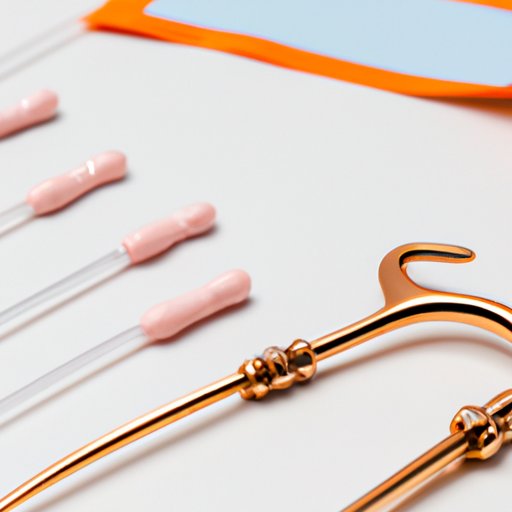Introduction
An intrauterine device (IUD) is a small, T-shaped device made from plastic, copper, and/or hormones that is inserted into the uterus to prevent pregnancy. It is one of the most effective forms of reversible birth control available today. There are two main types of IUDs: hormonal and copper. Each type has its own advantages and disadvantages, so it’s important to consider your options before making a decision.

Explaining the Different Types of IUDs and How They Work
Hormonal IUDs are small, plastic devices that contain the hormone progestin. Progestin is a synthetic form of the hormone progesterone, which is naturally produced in the body. The hormone works to prevent pregnancy by thickening the cervical mucus, which makes it harder for sperm to reach and fertilize an egg. It also thins the lining of the uterus, making it less hospitable for an embryo to implant. Hormonal IUDs can last for up to 5 years and are more than 99% effective at preventing pregnancy.
Copper IUDs are made from copper and plastic. They work by releasing copper ions into the uterus. These ions interfere with the movement and survival of sperm, preventing them from reaching and fertilizing an egg. Copper IUDs can last for up to 10 years and are more than 99% effective at preventing pregnancy.

The Benefits and Risks of Using an IUD
Using an IUD has many advantages. It is a long-term, highly effective form of birth control that does not require any daily maintenance or attention. It is also completely reversible: once the IUD is removed, fertility returns to normal immediately.
However, there are some risks associated with using an IUD. There is a very small risk of infection after insertion, as well as a risk of the IUD becoming dislodged or expelled from the uterus. Additionally, some people may experience irregular bleeding or spotting between periods while using an IUD.
How an IUD Can Help Prevent Unwanted Pregnancy
IUDs are one of the most effective forms of reversible birth control available today. According to a study published in the American Journal of Obstetrics & Gynecology, IUDs are more than 99% effective at preventing pregnancy. This means that fewer than 1 out of 100 women who use an IUD will become pregnant each year.
In addition to being highly effective, IUDs are easy to use and do not require any daily maintenance or attention. This makes them an ideal choice for people who want reliable birth control without having to remember to take a pill every day.
A Step-by-Step Guide to Inserting an IUD
Inserting an IUD is a relatively simple procedure that can be done in a doctor’s office. Before inserting the IUD, your doctor will perform a pelvic exam to make sure your uterus is healthy and measure the size of your uterus. You may be given antibiotics to reduce the risk of infection.
Once your doctor has determined that you are ready for insertion, they will use a speculum to open the walls of your vagina. Then, they will insert the IUD through your cervix and into your uterus. Finally, they will trim the strings attached to the IUD so that the device is secure. The entire process usually takes about 10 minutes.

Common Side Effects of Using an IUD
Most people do not experience any side effects when using an IUD. However, some people may experience physical side effects such as cramping, increased menstrual flow, and spotting between periods. In addition, some people may experience emotional side effects such as anxiety or depression.
If you experience any side effects from using an IUD, talk to your doctor. They may be able to adjust the dosage or recommend other forms of birth control.
Conclusion
An IUD is a small, T-shaped device made from plastic, copper, and/or hormones that is inserted into the uterus to prevent pregnancy. It is one of the most effective forms of reversible birth control available today. Hormonal IUDs contain the hormone progestin and can last for up to 5 years, while copper IUDs release copper ions into the uterus and can last for up to 10 years. Both types are more than 99% effective at preventing pregnancy.
Using an IUD has many advantages, including its long-term effectiveness, reversibility, and lack of daily maintenance. However, there are some risks associated with using an IUD, including the risk of infection, expulsion, and irregular bleeding. If you experience any side effects, talk to your doctor.
For more information about IUDs, consult your doctor or visit the ACOG website.
(Note: Is this article not meeting your expectations? Do you have knowledge or insights to share? Unlock new opportunities and expand your reach by joining our authors team. Click Registration to join us and share your expertise with our readers.)
